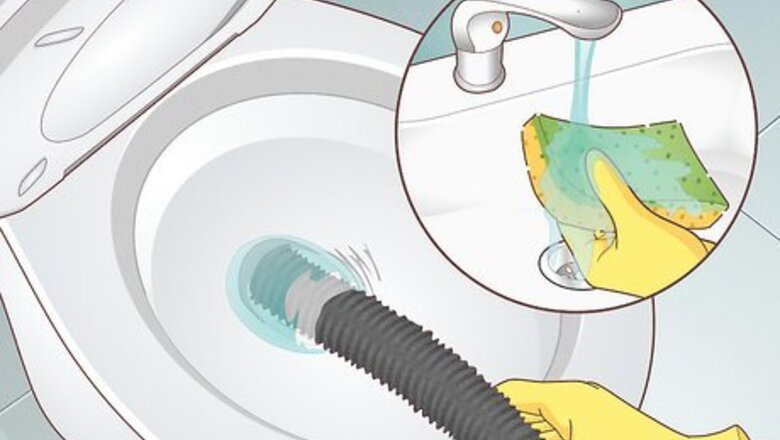
views
X
Research source
Those deposits can be quickly scrubbed away with a simple abrasive, and we’ll show you how to do just that using a cleaning powder or a pumice stone. We’ll also show you how to drain your toilet beforehand so you can get the deepest clean.
- Drain your toilet bowl of water by turning off the water valve and continuously flushing it until no water remains in the bowl.
- Sprinkle abrasive cleaning powder onto the metal marks, then scrub them away with a wet sponge.
- Clean the marks without abrasive powder by wetting a pumice stone with water and using very light pressure to rub the marks away.
Using an Abrasive Powder
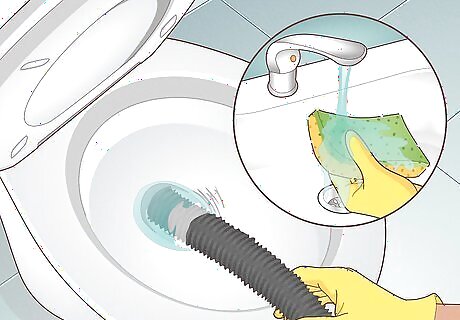
Drain your toilet and wet an abrasive sponge with water. First, drain your toilet of water so that you can work on the metal scuffs directly. Then, soak a sponge in tap water until it’s completely saturated. Use an abrasive sponge that’s rated for porcelain use, which is usually indicated on the sponge’s packaging. If you use a sponge with metal pieces in the material or a sponge that is not recommended for porcelain use, you may cause much more damage to the toilet than you are trying to fix. The backside of a kitchen sponge gets the job done, but be sure to avoid anything that isn't explicitly recommended for porcelain. Magic Erasers also work.
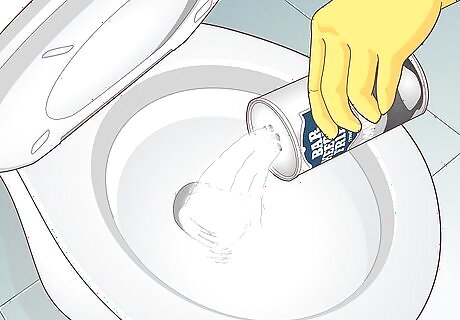
Sprinkle abrasive cleaning powder onto the metal marks. Tap some abrasive cleaning powder onto the marks, using just enough to completely cover them up. Or, tap a thin layer onto the sponge itself. Don't worry about getting the porcelain wet before scrubbing, as your sponge is wet enough to dissolve and activate the powder's cleaning properties. The most popular powders for metal marks are Bar Keeper's Friend and Bon Ami, though a generic ceramic stovetop cleaner makes a fine alternative. While Comet and Ajax are common and useful powder cleaners, they may lack the abrasive power of other cleaners. Baking soda may also work, but will be less effective.
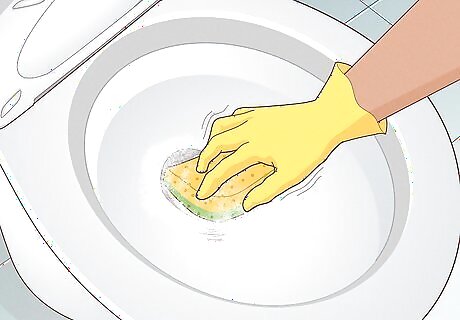
Rub the powder onto the mark until the mark is gone. Use moderate pressure to scrub the mark with the sponge and powder until the mark lifts. You may need to use some elbow grease to effectively clean the mark away, so don’t hesitate to use a bit more force if the scuff is stubborn. If your sponge dries out, run it under tap water in the sink and squeeze it to get rid of any excess powder. Then, drench it again and get back to scrubbing!
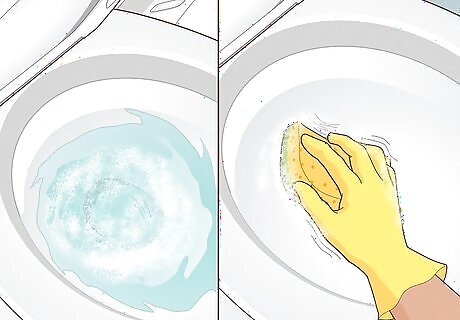
Wash away the residue and keep scrubbing the marks as necessary. Rinse away the powder and water residue with a stream of water or a damp cloth and check the marks to see if they have disappeared. If they have, job well done! If not, tap more abrasive powder onto the persistent marks, clean and re-wet the sponge, and scrub it again. Some marks are more "clingy" than others, so it may take a few attempts to get rid of them. Have patience and keep at it. Turn the toilet's water back on by turning the water valve counter-clockwise, then flush it 2 or 3 times to refill the tank.
Using a Pumice Stone
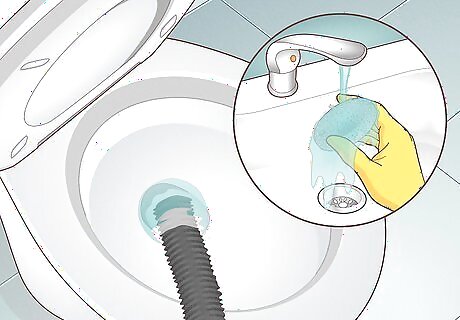
Drain your toilet and wet a pumice stone with tap water. First, drain your toilet of any water so you can clean the marks directly. Then, run the pumice stone under tap water to get the surface wet. A pumice stone is naturally abrasive and porous, so it absorbs water quickly. Wetting your pumice stone helps it to glide along the porcelain, preventing any new scratches. Clean your toilet bowl before you start removing marks so you don’t spread any germs or bacteria. Avoid using any special cleaning agents on the pumice stone, since it may absorb and transfer them to your next cleaning project. If you don't have a pumice stone, use a microfiber scouring and cleaning sponge, such as a Magic Eraser, as a viable alternative.
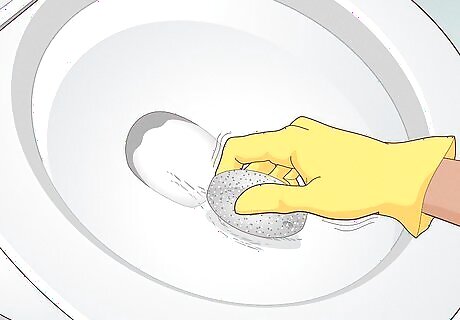
Rub the marks lightly with the stone, applying little to no pressure. Hold the stone so that one end is facing away from you and gently rub the metal marks. Use only slight pressure—start by barely pressing the pumice to the porcelain, and carefully increase the pressure if it isn’t scrubbing away the mark. A pumice stone also works on hard water stains or rings around the toilet bowl. Note that you may not be able to scrub away deep scratches or chips in the porcelain. Avoid using a pumice stone on the seat or lid of your toilet, which are often made of different materials and will be scratched by the pumice stone.
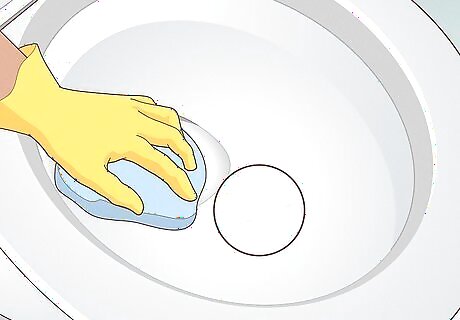
Rinse off the residue with water or a damp cloth and check the mark. Pour some water over the brown residue left by pumice stone to rinse it away, or use a damp cloth if the marks are outside the bowl. If there are marks left, simply go back over them and apply a little bit more pressure to lift them off. Big, black marks may require a little more elbow grease, but be careful not to press too hard or you may break the pumice stone or damage the finish on the porcelain. When you're finished, turn the water valve at the back of your toilet counter-clockwise to open it, then flush the toilet 2-3 times to refill the tank.
Emptying the Toilet to Access Marks
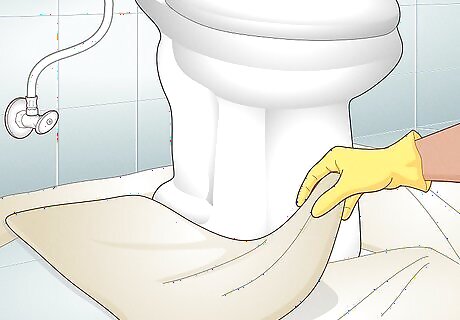
Lay towels around the toilet to protect the floor from splashes. Cover the floor around the toilet's base, including around the back side, with 2-3 towels to prevent water or cleaning powder from getting on the floor. Only use spare or old towels, since you may not want to use these again in the event of a spill.
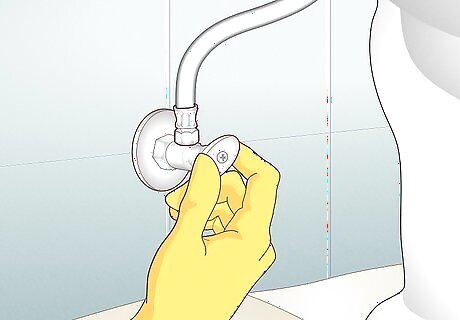
Turn off the water supply to the toilet. Almost every toilet has a shut-off valve around the rear, so reach back and turn the oblong valve clockwise to cut off the water supply. If you don't cut off the water supply, you won't be able to empty the tank and bowl to access the metal marks. If your metal marks are only on the outside of the toilet bowl, don't worry about turning off the water supply, as it won't get in the way of your work.
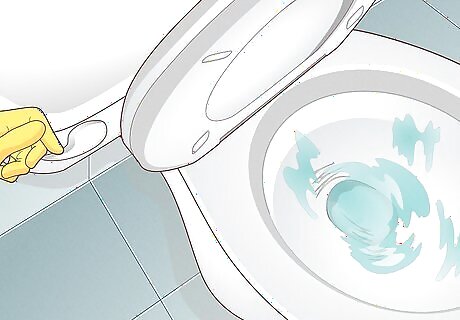
Hold down the toilet handle to drain all the water from the tank. Take off the tank lid and place it onto a towel, then hold down the toilet handle to flush the toilet and let all of the water drain out from the tank. The water in the bowl will mostly flush away, but there will be some remaining. This process may take several minutes. If your toilet doesn't automatically flush the water from the tank, flush it again when it gets full and then continue to hold down the handle. As long as nothing is left in the tank, you're ready to move on.
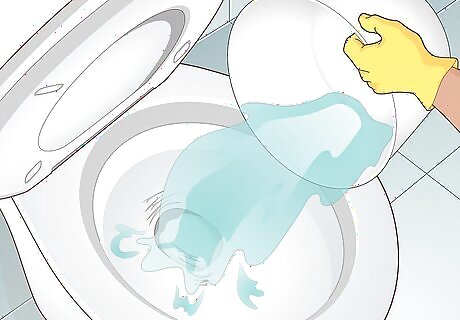
Pour water from a bucket into the toilet to flush it completely. There will still be some water left in the bowl, and the most effective way to get rid of this without flushing it with the handle is to pour about 3 US gal (11 L) of water into the bowl from a bucket. This simulates the force of a flush, and pushes water down into the pipes. Pour it from about 2 ft (0.61 m) above the toilet to simulate the flushing pressure. This is where the towels on the floor come in handy, as you may cause a little splash.
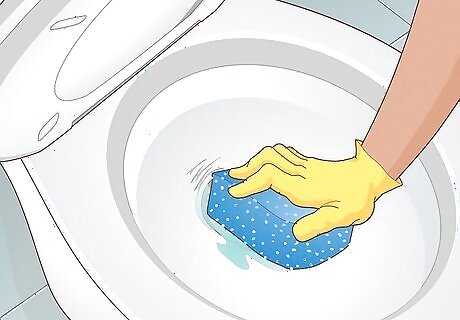
Use a large sponge to absorb any remaining water in the tank or bowl. Take a large, dry sponge and dab out any remaining water in the bowl and tank, the wring the sponge out into a bucket. As long as the marks are uncovered by water, they are ready to be scoured and cleaned away, but get rid of any remaining water as best as you can. You might also take this opportunity to clean out the bowl with bleach or a commercial toilet cleaner if it is especially dirty. After, simulate flushing again with a bucket of water before you continue with the cleaning process. To refill the toilet when you're finished cleaning, turn the water valve all the way counter-clockwise, then flush the toilet 2-3 times.




















Comments
0 comment